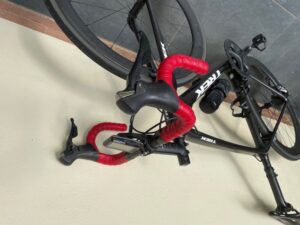Like many people I hope to return to my office this autumn for a few days a week. While I am looking forward to catching up with long standing colleagues I haven’t seen for sometime and meeting some of my students in person for the first time, my desire for sociality is tempered by a deep concern for the need to decarbonise my working practices. One of the ways I intend to do this is to avoid the easy path of using my car to travel to and from work but to restart cycle commuting.
Fortunately, I love cycling. I find it’s rhythms and the sensations quite intoxicating. I first started cycling seriously in 1982 when I embarked on amateur racing. Cycle commuting has always formed part of my training schedule. I live in Bedford and work at the OU’s Walton Hall campus in Milton Keynes. The commute is a round trip of 30 to 40 miles along familiar roads, with interesting uphill sections and very fast flat sections which with a good tail wind can make me feel at least 25 years younger!
As I return to cycle commuting, I have been struck by the array of new smart digital cycling technologies on offer. For many years I used to simply measure the distances and speeds of rides using mechanical devices attached to the front wheel of my bike. In turn, I would faithfully record these in a paper training diary, along with reflections on how I felt during the ride and details of weather conditions. In contrast today my GPS enabled digital cycle (see Figure 1) computer measures distance and speed as well as average speed, elevation, pedal cadence, my heart rate via a sensor strapped to my chest and even my power output via a strain gauge on the crank arm. I don’t even have to record these metrics in my cycling diary, instead they are automatically uploaded to a ride logger, in my case Strava.

Figure 1 – GPS enabled cycle computer mounted on racing bike.
In this way, each of my cycle rides is not merely a calorie deficit or even a memory but a kind of digital artefact which lives on after the ride. As ride loggers are social platforms (I have about 50 followers on Strava), these digital artefacts are open to the gaze of others; my paper cycling diary is no longer closed on the shelf at home but open to the scrutiny of my peers. This matters not least because cycling used to be a private somewhat solitary activity through which I could ‘escape’ everyday life. But also because ride loggers include gamification elements such as ‘segments’ of routes on which riders compete for placings on leader boards, they create an almost constant pressure to perform and maintain social standing.
Of course, the sociality of amateur sports and their pervasive ‘atmospheres of competition’ should not be overlooked. Team camaraderie and competition can simply be good fun and form the basis of enduring relationships. But while ride loggers give the impression one never rides alone, their gamification and social endorsement elements can mean every ride, particularly in summer, can feel like a race. And for long standing cycle racers such as me I feel pressure to perform to not only to tell a story to others which maintains my social standing among my peers but more subtly to keep telling a story to myself: that I can still ‘do it’.
I am sure that I am not alone in these thoughts and I recognise that they are those of an amateur cycle racer. For others, ride logging may afford other opportunities and present different challenges. Whatever these may be, there is little doubt that like many everyday practices digital technologies have played a major role in reshaping them, sometimes for better and/ or worse. In the case of cycling, as I swing my leg over my carbon fibre digitally augmented racing bike and sensors bleep to recognise my presence and tell me ‘I am alive’, I can’t help thinking whatever happened to the elegant simplicity of going out for a cycle ride to sort my thoughts and prepare for the coming day or week?
Returning to the (re)creation of more sustainable low carbon futures, I am certain that everyday practices such as cycle commuting and new digital technologies will play a key role in such endeavours. But we will need to carefully scrutinize the scripts embodied in them and attendant human behaviour to ensure so called ‘smart’ technologies underpin rather than foreclose wise decision making. For example, cycle commuting is often promoted by transport to encourage people to get out of polluting cars and onto bicycles to ‘green’ cities. Data on commuting patterns from ride loggers such as Strava are made available to such initiatives. Yet these are not simple reflections of cycling practices as through among others their gamification elements ride loggers script and reshape cycle practices, and therefore are far from innocent actors. While transport planning is undoubtably contingent it is a field of bias where the scripts of digital technologies increasingly matter. Thus we need to continually explicate the relations between technological change and urban development to avoid deleterious futures in which humans are further alienated from the environments in which we dwell for if anything, sustainability requires us to reconnect with nature not further distance ourselves from it.

Leave a Reply